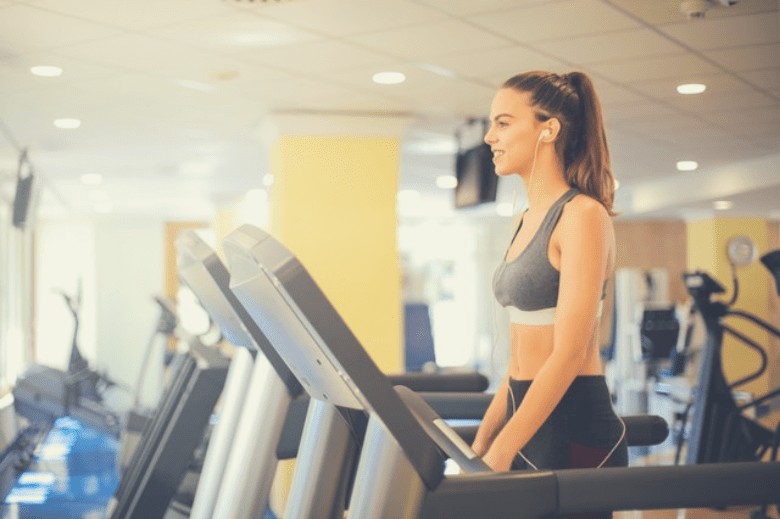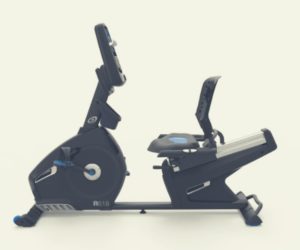Treadmills have become one of the most popular pieces of fitness equipment on the market.
You can find these running machines at almost all commercial gyms. Many health clubs even require members to sign up for slots to use these machines.
After trying one at the gym, you might think that having your own treadmill would help you work out at home.
Please read on about some of the significant treadmill disadvantages below before you make your final decision.
Going Nowhere Fast…Literally
Treadmills feature either a manual or motorized belt that allows you to run in place.
If you already have an established running routine outdoors, then you will likely not mind using a treadmill.
However, many people find treadmills to be boring.
Unlike weight training or other workout options, running on a treadmill is a highly repetitive exercise.
You can either walk or run on the belt, but it is hard to really vary your workout on a treadmill.
Sure, some higher-end treadmills have virtual running courses, simulated inclines and declines and other features to try and keep you more interested during your workout.
However, at the end of the day, you are primarily performing a cardio exercise.
You may build some endurance and leg muscles with a treadmill.
However, one major disadvantage to the treadmill compared to other equipment is that you cannot easily work your upper body or other muscle groups without getting creative.
In contrast, ellipticals and even some stationary bikes have moving handlebars that help you use more parts of your body at once.
Depending upon your level of intensity, you may find that other pieces of equipment burn more calories per hour and are more interesting than a treadmill.
Fact or Fiction: Treadmills are a Good Low-Impact Workout?
Fiction! Another one of the treadmill disadvantages is that they can be very hard on your legs, knees, back and other joints.
Many treadmills designed for home use only have thin treads and do not provide much cushion when you run.
These forces can lead to a number of painful issues, including:
Runner’s Knee
The repetitive motion of striding on the treadmill can lead to issues like runner’s knee, or patellofemoral pain syndrome (PFPS).
Damage to the cartilage and muscles in your knee from these impacts can irritate the area around your kneecap and cause PFPS.
Plantar Fasciitis
Similarly, one of the other treadmill disadvantages is foot injuries. When you run, your feet have to absorb vibrations and forces that can be as much as three to seven times your own body weight.
If you weigh 150 pounds, then you could be exposing your feet to up to 1,000 pounds of force or more.
As you can imagine, with that much force being applied to their feet, almost 15% of runners’ injuries are foot-related.
One of the most common foot injuries that you may experience is plantar fasciitis.
Plantar fasciitis is defined as inflammation of the muscles, tendons and other tissues that run in your feet between your heel and your toes.
Over 3 million people suffer from this condition every year.
Signs that you have plantar fasciitis include strong heel pain. This discomfort may be more severe in the morning when the muscles in your feet are tight from sleeping overnight.
You may need physical therapy, specialized orthotics, or shoe inserts, to help reduce this irritation and let your feet heal.
If you develop tears in these foot tendons, then you may actually need cortisone injections or surgery on your feet to relieve this pain.
Shin Splints
Almost everyone who runs on a treadmill or outside experiences shin splints.
This condition causes a sharp pain across the front of your tibia, or shin bone. The tibia is located below the knee. It is the bone that connects your knee and your ankle.
Ten percent of runners each year experience this shin pain. It is caused by tiny tears in the muscles around the tibia.
Unfortunately, when you feel this pain in your leg it means that you need to slow down and rest. It may take weeks to fully heal.
Unfortunately, if you are new to using the treadmill or if you are coming back to this machine after not using it for an extended period of time, then you are at a higher risk for shin splints.
Shin Splints typically occur when you try to do too much too quickly on the treadmill.
Perhaps most concerning is that, if untreated, shin splints can actually lead to a broken tibia or other leg bone.
Rest and reduced activity is critical to ensure that shin splints do not become more serious.
Balance Issues
Traditional motorized treadmills may not be the best choice for people with balance issues.
The moving belts can be extremely unforgiving if you slip and lose your footing while walking or running on a treadmill. This is another serious example of treadmill disadvantages.
Not only could you twist an ankle, but you could actually fall off the back of the treadmill.
Many treadmills do not have an auto-off feature, which would mean that the belt would keep moving even if you lost your footing.
Fortunately, there are alternative exercises that are truly low impact and can eliminate this major treadmill disadvantage.
For example, swimming will pose significantly less risk to your back, knees, feet and other joints.
Because your body is largely underwater, there is very little pressure on your joints.
Likewise, exercising on a high-quality elliptical will provide much lower impact on your knees and other joints.
This reduced stress is largely due to the fact that your feet do not actually strike the ground while you are on the machine.
The Cost and Space Requirements for a Treadmill

The Initial Purchase Price: How High Can It Go?
Even budget friendly motorized treadmills start around $1,000.
At that price-level, cost is another one of the treadmill disadvantages compared to other options. Unfortunately, these cheaper options often have less padding and less expensive components.
For example, they are typically constructed with less powerful motors that limit their top speed to 10 miles per hour or less.
These treadmills will also likely only have limited incline capabilities and not be able to decline at all.
In addition, these cheaper models often have only basic displays that track time, distance and calories burned, but little else.
You will need to spend significantly more money to get the interactive displays with virtual running courses that you see in commercial gyms.
Commercial grade treadmills start at between $3,000 and $5,000. These models come with more advanced displays and more durable motors.
These upgraded features would enable you to run at speeds up to 15 miles per hour.
If you want more substantial cushioning and specialized treads to help lower the stress on your feet and knees, then you could spend as much as $20,000 or more.
These versions do have higher user weight capacities up to 500 pounds, but come at a steep price.
Other Cost Considerations
However, even if you opt for a high-grade commercial treadmill, these models have other drawbacks.
First, the most durable and well-cushioned options can weigh up to 350 pounds or more. You will most likely not be able to easily move this equipment yourself.
In fact, you may need to pay someone to professionally deliver and assemble this equipment. This service can cost $150 or more on top of your initial purchase price.
Other commercial treadmill disadvantages arise from their complex parts and systems.
If you consistently use your treadmill, then the belts, rollers and cushions will eventually wear out. Sweat or other liquids could get into the controls if not properly maintained.
These issues will require you to purchase replacement parts, which will only increase this equipment’s total cost.
Space Requirements
Another critical example of treadmill disadvantages is the space you will need in your home to use them.
Most treadmills have running decks that are at least 18 to 22 inches wide. This width is critical to make sure that you have enough space to run on the belt without slipping.
Many treadmills have belts that are at least 58 inches long. This length is important because it will allow you to have a natural stride while you are running.
The longer the belt, the less likely you will be to slip off of the belt.
In addition to the machine’s physical dimensions, you will also need space around it to comfortably get on and off of the treadmill.
The American Society of Testing Materials (ASTM) recommends that you have 2 feet of space on either side of the treadmill for you to step on and off.
Furthermore, at least 3 feet, but preferably 6 feet, of space behind it will help minimize your risk for more severe injuries if you were to slip and fall off of the belt.
An additional 2 feet in the front is recommended to allow the treadmill’s motor to get sufficient airflow.
Essentially, you will need at least 60 square feet of area for your new treadmill.
This space requirement is another prime example of treadmill disadvantages when compared to other workout options.
For example, free weights require as little as 20 to 50 square feet depending upon if you use a weight bench.
Resistance bands, step aerobics and other forms of exercise also need significantly less space than a treadmill.
You Can’t Take It with You
One final issue is that the machine is not portable. You will generally have to run in the same room day after day.
This lack of variety is another instance of treadmill disadvantages as opposed to other fitness equipment choices.
Free weights, resistance bands or bodyweight exercises can all be done on the go. These options can be light enough to pack with you to bring on a trip.
This flexibility will allow you to keep up your exercise routine even when you are away from home,
Final Thoughts

Treadmills are certainly popular for a reason. They are relatively easy to use and allow you to burn more calories per hour than just about any other piece of fitness equipment.
However, treadmills’ disadvantages can far outweigh these benefits.
First, treadmills primarily provide cardio exercise, which improves your heart’s strength and pumping ability.
However, they do not provide a workout for your arms, upper body and back. Other options, such as an elliptical, provide more of a total body workout.
The fact that the treadmill primarily works your heart, legs and feet means that it can cause stress injuries to those areas of your body.
This situation is particularly true if you overdo it when you first start running or when you go back to running after a long layoff.
Plantar fasciitis, hamstring injuries and other leg or foot conditions are a major concern when considering a treadmill.
Other forms of exercise, such as swimming, will provide similar cardio benefits while also providing a workout for your arms and legs.
The other important factors to consider are the cost and space requirements for a treadmill.
High quality models that include improved shock absorption for your legs, feet and other joints can cost at least $2,000.
Versions with high resolution consoles, specialized running decks and other upgrades can cost you as much as $20,000 or more for a high-end commercial-grade unit.
These initial upfront costs plus the expected maintenance bills over the course of these treadmills’ lives may make them prohibitively expensive.
Overall, you may decide that treadmills’ disadvantages are serious enough to justify looking at other options.
Fortunately, there are many other pieces of equipment that you can use to get fit. Many of these choices will provide a more complete workout.



